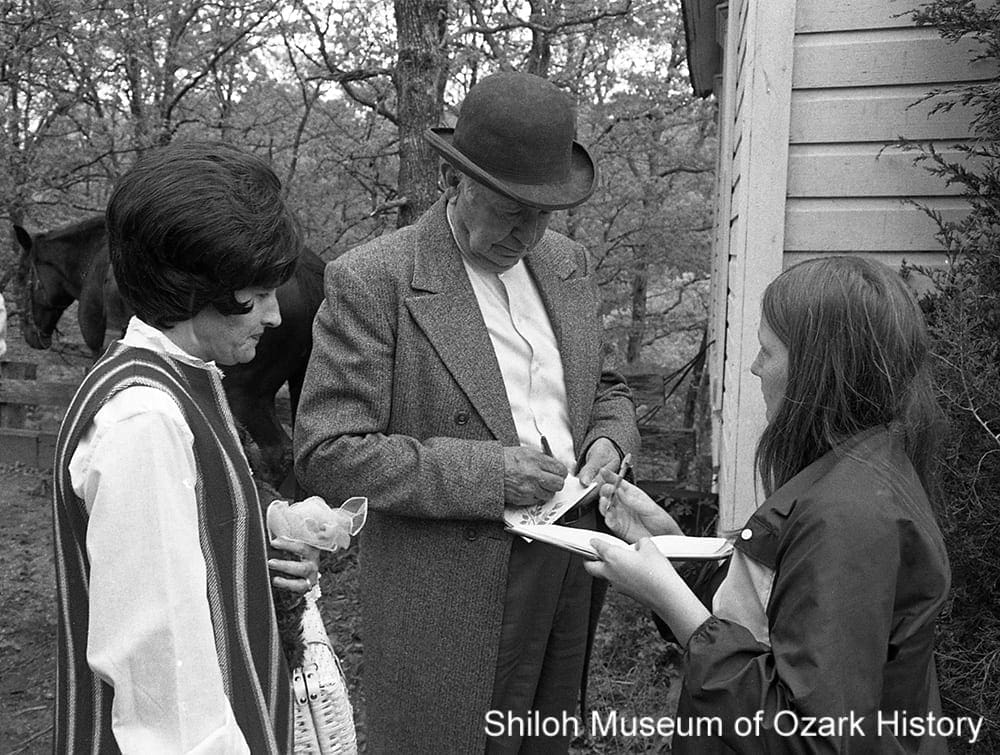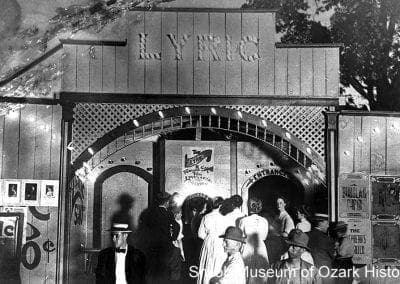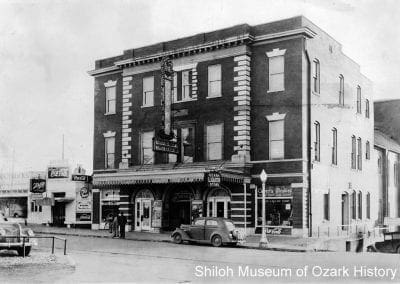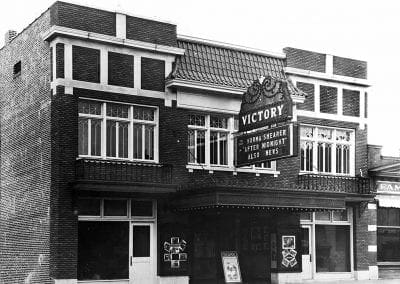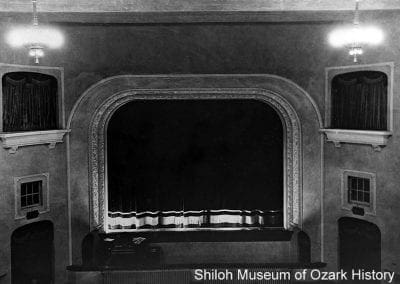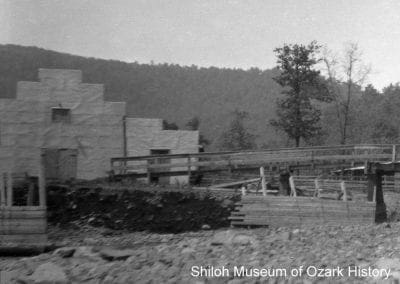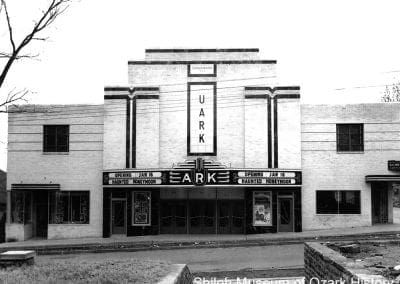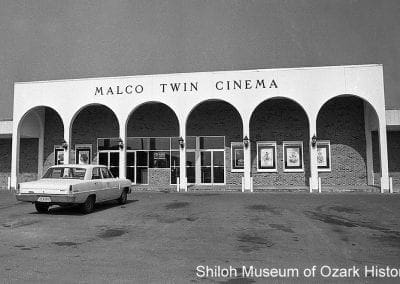Silver Screen Memories
Online ExhibitNorthwest Arkansas was likely first seen nationally on the big screen in the 1939 movie Jesse James, starring Tyrone Power and Henry Fonda. While only a small portion of the film was made locally, it was the first of many productions to showcase the area’s natural beauty and resources. Since then over two dozen motion picture and television productions have been filmed in the region, pumping money into the local economy, providing work for actors and crew, and offering a novel experience to star-struck residents.
Community Impact
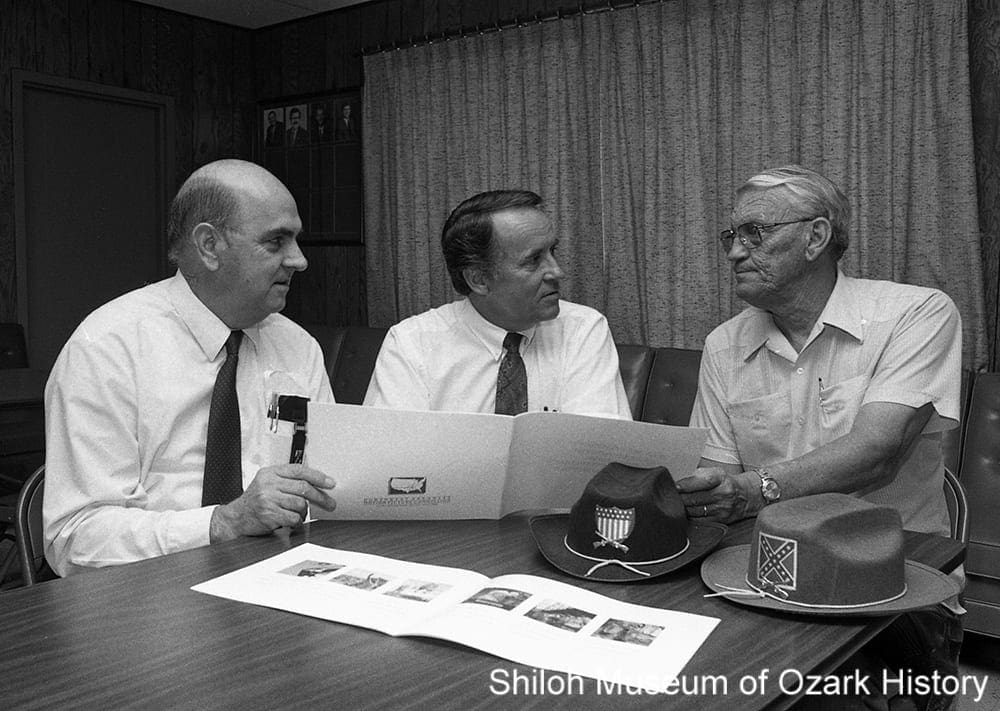
Members of the Northwest Arkansas Motion Picture Commission look over its promotional materials, with souvenir hats from The Blue and the Gray. From left: Lee Zachary (special projects committee chairman), State Representative Bill Ramsey (commission chairman), and Phil Phillips Sr. (locations committee chairman), Springdale Chamber of Commerce, July 30, 1987. Charles Bickford, photographer. Springdale News Collection (SN 7-30-1987)
Movie fever can grip a community. Hundreds of area residents made the trek to southwest Missouri to watch the filming of Jesse James and hope for an autograph from matinee idol Tyrone Power. During the 1981 filming of The Blue and the Gray, one report said that about 10,000 people applied for jobs as extras and crew. When a press conference with actor Gregory Peck was scheduled, the Northwest Arkansas Times sent one reporter to cover it; three showed up.
The economic impact of filmmaking spreads far into the community, beyond the folks directly involved with a movie’s production. It was expected that restaurants and hotels would greatly benefit during the production of The Blue and the Gray, but an economic impact study showed that other businesses benefited as well, including lumber companies, dry cleaners, and car-rental agencies.
Films can cause property damage, despite the best intentions. While filming Fighting Mad in 1975, one man had his truck door accidentally torn off. He was compensated with $400 and a new engine. The historic Borden House at Prairie Grove Battlefield State Park received minor damage from an explosion in a new wing built specifically to be blown up for The Blue and the Gray. By the next day, the house was repaired and a donation of $5,000 offered towards its further restoration. It’s unclear if the money was received.
Sometimes storylines or cast and crew can rub folks the wrong way. Protests arose surrounding Pass the Ammo, a 1988 spoof about crooked televangelists filmed in Eureka Springs. Some pastors denounced it as full of “nudity, sex, obscenity, perversity, drugs, vulgarity, racism, and violence.” To keep it from being filmed, the Elna N. Smith Foundation, owners of the “Christ of the Ozarks” statue, had it draped in black plastic. When Frank and Jesse was filmed in 1993, one extra noted that everyone loved country singer and actor Randy Travis, but had less than kind words to say about star Rob Lowe.
Economic Impact
Attempts to lure motion picture and television productions to Arkansas began officially in 1979, when a part-time employee of the Arkansas Industrial Development Commission was assigned to work with prospective film crews.
When Columbia Pictures Television was deciding whether to shoot The Blue and the Gray in Kentucky or Arkansas, various individuals and entities worked to woo the production team to the state’s northwest corner. To transport executives to possible shooting locations, they arranged for airplanes from local poultry giant Hudson Farms and transportation companies Jones Truck Lines and Polar Express. Springdale funeral home director Charles Farmer lent limousines.
In 1982 the Northwest Arkansas Motion Picture Commission was formed by the chambers of commerce in Springdale, Rogers, Siloam Springs, Fayetteville, and Eureka Springs. It was created because of the economic impact of The Blue and the Gray and with the encouragement of CBS-TV and Columbia Pictures, which appreciated the area’s beauty and cooperative residents, and the economic advantage of filming here.
As a marketing entity, the commission worked to “keep [its] name in front of the people that make the decisions.” To that end it produced a brochure, helped find prospective shooting locations, and served as lobbyists, traveling to Hollywood to meet with movie-industry representatives. The commission was the first in the state; by 1987, about 50 similar organizations had sprung up. The commission closed its doors sometime in the 2000s due to lack of interest and sponsors.
State legislators jumped on the movie bandwagon in 1983, passing the Motion Picture Incentive Act. Known as “The Nickel Rebate,” filmmakers spending at a certain level received five cents back for every production dollar spent in the state. Arkansas was the first state to make such an offer; others soon followed.
Over the years laws were enacted and various state agencies created to promote film production, with varying degrees of success. Today, surrounding states offer better incentives, perhaps explaining why Arkansas’ film production has dropped in recent years.
Films Today
Small, independent films are being made in Northwest Arkansas such as Gordon Family Tree (2012) and Valley Inn (2014). To meet the demand for films and commercials, new businesses have sprung up, including talent and casting agencies and visual effects and post-production companies. In 2013 locals were recruited as extras and Razorback football fans for the movie Greater: The Brandon Burlsworth Story (2016).
Interest in local filmmaking and film festivals are on the rise. In 2014 Eureka Springs passed an ordinance providing economic incentives in the form of tax rebates to film, digital, and television productions. The ordinance made Eureka the first town in Arkansas to offer such a rebate. The area has had a few short-lived film festivals over the years. Currently, the longest running is the Fayetteville Film Festival. Begun in 2008, it works to showcase independent films in a community-oriented atmosphere. Newer festivals include the Eureka Springs Indie Film Festival, the Canted Angle Film Festival in Harrison, and the Bentonville Film Festival. The latter was co-founded in 2015 by actor Geena Davis in an effort to promote “underrepresented voices of diverse storytellers.” The festival quickly made its mark on the local landscape through increased tourism, marketing opportunities, and new businesses. After years without a movie theater, Bentonville is now home to the six-screen Skylight Cinema with rocking recliners and a full-service restaurant and bar. The festivals’ impact have encouraged several film production companies to set up shop, including Fayetteville’s Rockhill Studios in Fayetteville and Hiwasse’s Farm Studios and Intercut Productions.
Community Impact
Movie fever can grip a community. Hundreds of area residents made the trek to southwest Missouri to watch the filming of Jesse James and hope for an autograph from matinee idol Tyrone Power. During the 1981 filming of The Blue and the Gray, one report said that about 10,000 people applied for jobs as extras and crew. When a press conference with actor Gregory Peck was scheduled, the Northwest Arkansas Times sent one reporter to cover it; three showed up.

Members of the Northwest Arkansas Motion Picture Commission look over its promotional materials, with souvenir hats from The Blue and the Gray. From left: Lee Zachary (special projects committee chairman), State Representative Bill Ramsey (commission chairman), and Phil Phillips Sr. (locations committee chairman), Springdale Chamber of Commerce, July 30, 1987. Charles Bickford, photographer. Springdale News Collection (SN 7-30-1987)
The economic impact of filmmaking spreads far into the community, beyond the folks directly involved with a movie’s production. It was expected that restaurants and hotels would greatly benefit during the production of The Blue and the Gray, but an economic impact study showed that other businesses benefited as well, including lumber companies, dry cleaners, and car-rental agencies.
Films can cause property damage, despite the best intentions. While filming Fighting Mad in 1975, one man had his truck door accidentally torn off. He was compensated with $400 and a new engine. The historic Borden House at Prairie Grove Battlefield State Park received minor damage from an explosion in a new wing built specifically to be blown up for The Blue and the Gray. By the next day, the house was repaired and a donation of $5,000 offered towards its further restoration. It’s unclear if the money was received.
Sometimes storylines or cast and crew can rub folks the wrong way. Protests arose surrounding Pass the Ammo, a 1988 spoof about crooked televangelists filmed in Eureka Springs. Some pastors denounced it as full of “nudity, sex, obscenity, perversity, drugs, vulgarity, racism, and violence.” To keep it from being filmed, the Elna N. Smith Foundation, owners of the “Christ of the Ozarks” statue, had it draped in black plastic. When Frank and Jesse was filmed in 1993, one extra noted that everyone loved country singer and actor Randy Travis, but had less than kind words to say about star Rob Lowe.
Economic Impact
Attempts to lure motion picture and television productions to Arkansas began officially in 1979, when a part-time employee of the Arkansas Industrial Development Commission was assigned to work with prospective film crews.
When Columbia Pictures Television was deciding whether to shoot The Blue and the Gray in Kentucky or Arkansas, various individuals and entities worked to woo the production team to the state’s northwest corner. To transport executives to possible shooting locations, they arranged for airplanes from local poultry giant Hudson Farms and transportation companies Jones Truck Lines and Polar Express. Springdale funeral home director Charles Farmer lent limousines.
In 1982 the Northwest Arkansas Motion Picture Commission was formed by the chambers of commerce in Springdale, Rogers, Siloam Springs, Fayetteville, and Eureka Springs. It was created because of the economic impact of The Blue and the Gray and with the encouragement of CBS-TV and Columbia Pictures, which appreciated the area’s beauty and cooperative residents, and the economic advantage of filming here.
As a marketing entity, the commission worked to “keep [its] name in front of the people that make the decisions.” To that end it produced a brochure, helped find prospective shooting locations, and served as lobbyists, traveling to Hollywood to meet with movie-industry representatives. The commission was the first in the state; by 1987, about 50 similar organizations had sprung up. The commission closed its doors sometime in the 2000s due to lack of interest and sponsors.
State legislators jumped on the movie bandwagon in 1983, passing the Motion Picture Incentive Act. Known as “The Nickel Rebate,” filmmakers spending at a certain level received five cents back for every production dollar spent in the state. Arkansas was the first state to make such an offer; others soon followed.
Over the years laws were enacted and various state agencies created to promote film production, with varying degrees of success. Today, surrounding states offer better incentives, perhaps explaining why Arkansas’ film production has dropped in recent years.
Films Today
Small, independent films are being made in Northwest Arkansas such as Gordon Family Tree (2012) and Valley Inn (2014). To meet the demand for films and commercials, new businesses have sprung up, including talent and casting agencies and visual effects and post-production companies. In 2013 locals were recruited as extras and Razorback football fans for the movie Greater: The Brandon Burlsworth Story (2016).
Interest in local filmmaking and film festivals are on the rise. In 2014 Eureka Springs passed an ordinance providing economic incentives in the form of tax rebates to film, digital, and television productions. The ordinance made Eureka the first town in Arkansas to offer such a rebate. The area has had a few short-lived film festivals over the years. Currently, the longest running is the Fayetteville Film Festival. Begun in 2008, it works to showcase independent films in a community-oriented atmosphere. Newer festivals include the Eureka Springs Indie Film Festival, the Canted Angle Film Festival in Harrison, and the Bentonville Film Festival. The latter was co-founded in 2015 by actor Geena Davis in an effort to promote “underrepresented voices of diverse storytellers.” The festival quickly made its mark on the local landscape through increased tourism, marketing opportunities, and new businesses. After years without a movie theater, Bentonville is now home to the six-screen Skylight Cinema with rocking recliners and a full-service restaurant and bar. The festivals’ impact have encouraged several film production companies to set up shop, including Fayetteville’s Rockhill Studios in Fayetteville and Hiwasse’s Farm Studios and Intercut Productions.
Filmed in Northwest Arkansas
Jesse James (1939)
Starring Tyrone Power, Henry Fonda, Nancy Kelly, Randolph Scott
Filmed August–October 1938, primarily in and around Pineville, Missouri; also Benton County, between Hiwasse and Gravette.

Henry Fonda as Frank James, on the set of Jesse James, Pineville, Missouri, 1938. Mary Lucile Lewis Yoe Collection (S-2002-51-14)
Carpenters, painters, wagon masters, and extras transformed Pineville, Missouri, into the fictional town of Liberty for the movie Jesse James. Wood planks, painted gray to simulate age, covered concrete sidewalks and hitching posts were installed. At one point, a large flock of guinea hens ruined a dramatic scene. Young boys were paid thirty-five cents per bird to round them up and move them away.
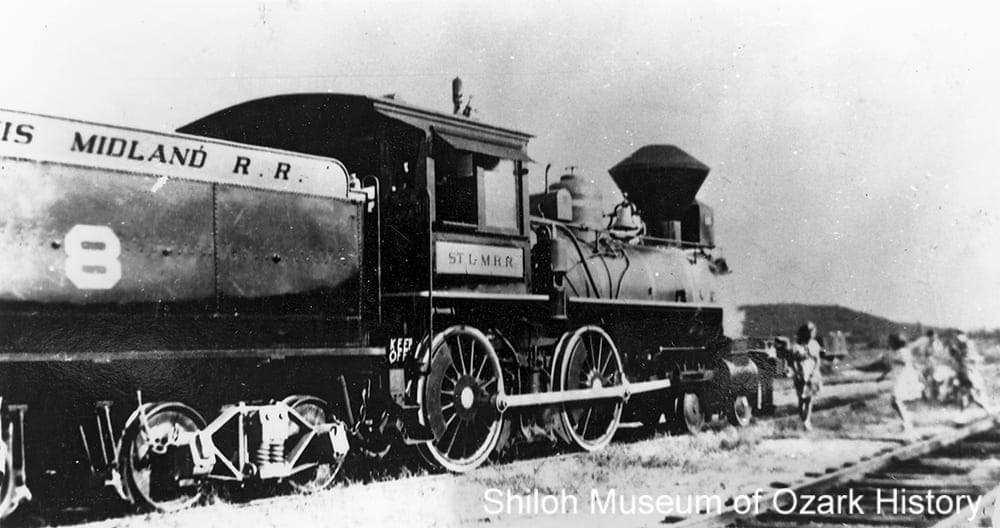
Fictional St. Louis Midland Railroad engine on the Frisco’s Bentonville Branch, Benton County, 1938. Marion E. Bayles Sr. Memorial Collection (S-85-49-25)
Some of the scenes featuring the fictional St. Louis Midland Railroad were filmed on the Bentonville branch of the St. Louis-San Francisco Railway between Hiwasse and Gravette. The Bentonville branch was ideal, because it had little traffic by the 1930s. Frisco rail cars and equipment were re-lettered especially for the movie.

Sightseers and film crew on the set of Jesse James, Pineville, Missouri, 1938. Jo Condra, photographer. Jim Morriss Collection (S-2014-81-5)
Over $200,000 was spent by the movie company and by an estimated 200,000 tourists, including some from Northwest Arkansas, who came to watch Hollywood stars in action. One story tells of hundreds of University of Arkansas students who neglected their classes to make the drive to Missouri. One young woman, Mary Margaret Bowen, was hoping to get heartthrob Tyrone Power’s autograph, but fainted as a result of the day’s heat and crowd. Luckily for her, Power came to the rescue, carrying her into the coach of the train, “where he patted her wrist and fanned her to recovery.”
Wonder Valley (1953)
The complicated tale of a young man, loved by two women, who needs money to improve his farm, only to receive a loan from a man whose son then steals the money.
Starring Gloria Jean, Lance Devro, Louise Larrimer, Walter Kingsford, Mirna Liles, Governor Sid McMath
Filmed September–October 1951 in Cave Springs (Lake Keith), Springdale (Hitchin’ Post Café), and Fayetteville (University of Arkansas).
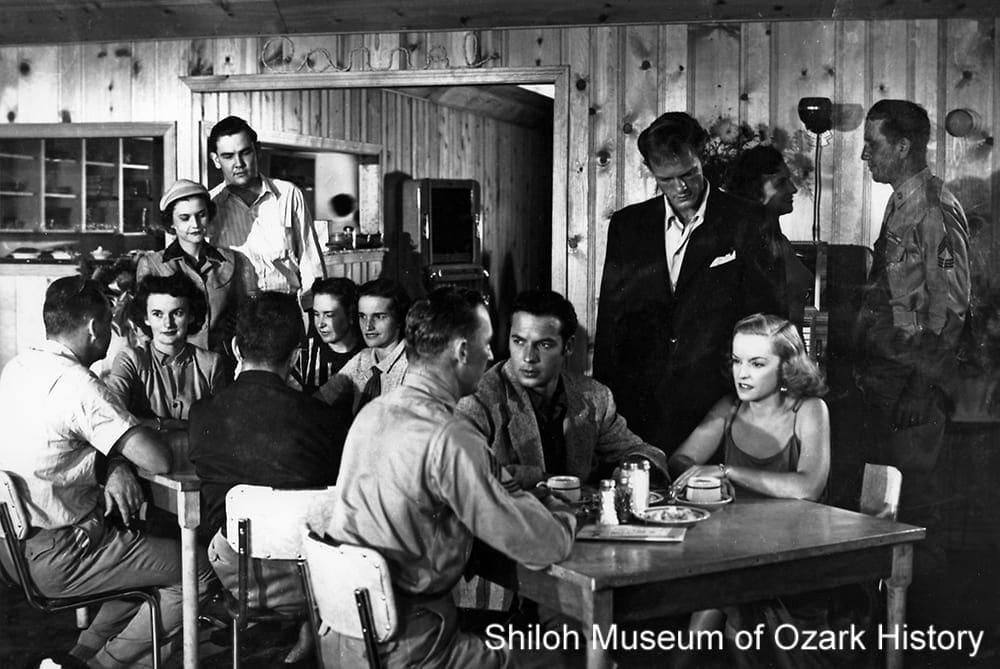
Wonder Valley actors and extras at the Hitchin’ Post Café, Springdale, September 27, 1951. With actor John Fontaine (seated at front table, middle) and locals Betty Walker and Teena Carpenter (seated at back table, left and right, respectively), Wayne High (standing at back table), and U.S. Marine Corps Master Sergeants Paul Hodges (sitting at front table, with back to camera) and James Toopes (standing, far right). Teena Carpenter Collection (S-2004-57-1)
Viva Ruth Liles of Russellville, Arkansas, produced Wonder Valley (originally titled Seven Wonders), the first movie filmed entirely in the state. Liles hoped to establish a motion-picture production office in Arkansas, saying that movies made here would be less expensive than Hollywood and would showcase the area’s wonderful scenery. Filming and operations for Wonder Valley were based at Lake Keith, a tourism spot in Cave Springs that offered barracks-style buildings and a restaurant for cast and crew.
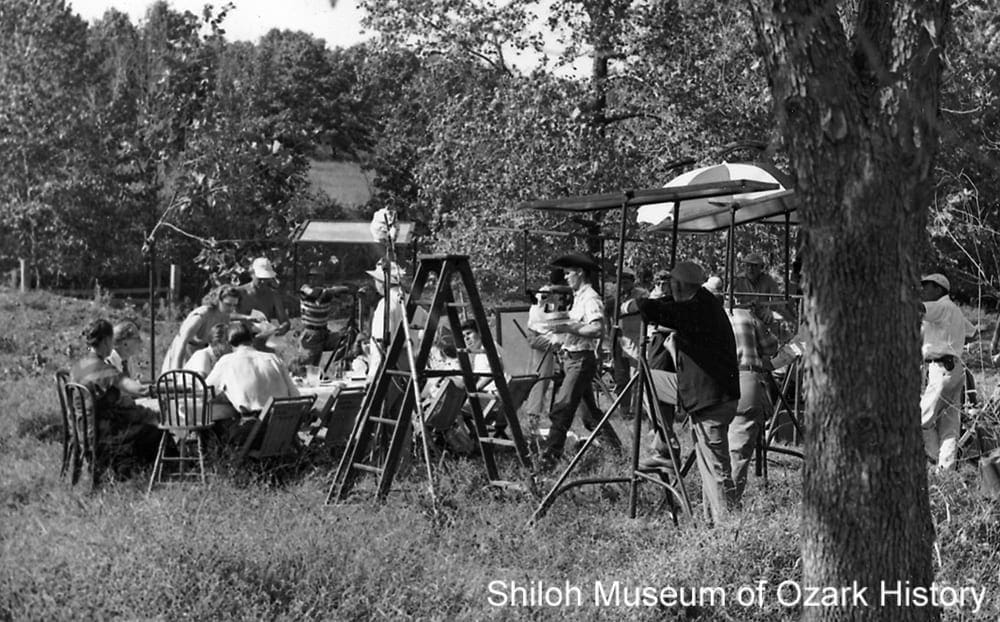
Shooting a dinner scene for Wonder Valley, Cave Springs, September 1951. Howard Clark, photographer. Caroline Price Clark Collection (S-2002-72-2478)
The film focused on the Wonder family and featured former child star Gloria Jean and actors Lance Devro, John Fontaine, and Walter Kingsford. Actors, crew, and community came together. Kingsford helped with a fundraising auction for the Springdale swimming pool. The Hollywood folks attended a pie supper to raise money for the Cave Springs fire department. Governor Sid McMath had a small role, playing himself. Several Springdale folks were used as extras when a scene was shot at the Hitchin’ Post Café on Emma Avenue. Locals were treated to “rushes” (screenings of unedited film) at the Victory Theatre in Rogers and the Apollo Theatre in Springdale.
Glenn Jones remembers when the film crew came to shoot a scene at Lake Keith. It was “all the locals talked about day and night.” He watched some of the filming but was “bored stiff,” wishing he was out playing in the fields and creeks. After his grandmother bought a “Lake Keith” postcard from an enterprising salesman, stars Gloria Jean and John Fontaine saw him with it and autographed it for him. Young Glenn “wasn’t impressed since [he] had never heard of either of them.”
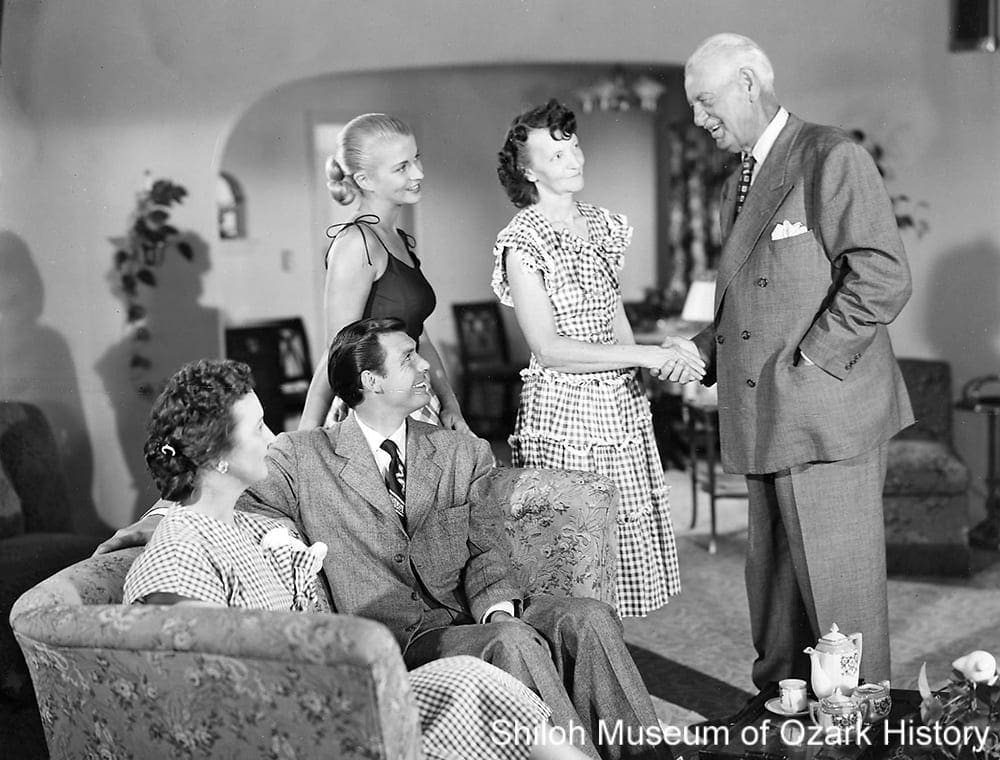
Actors possibly rehearsing a scene for Wonder Valley in Colonel Meyer’s Cave Springs home, September 1951. With Gretchen Steele of Springdale (seated) and Thelma Stroud Mischler of Cave Springs (standing, center), and actors Lance Devro (seated) and Lisa Abbott and Thurston Hall (standing left and right). Charlotte Steele Collection (S-2014-68)
The film was troubled from the start. Shooting locations and dates didn’t occur as announced. Producer Liles tried to interest local leaders in buying stock in her Wonder State Motion Picture Company to help fund the film’s production. While several thousands of dollars were said to have been raised in Springdale, Fayetteville folks remained skeptical. In October, filming halted when actors and technicians walked off the set, claiming they hadn’t been paid. Liles remarked that those reports weren’t true, as she headed off to Hollywood to raise funds. A few days later the motion picture company filed for bankruptcy. In 1952 the court bankruptcy trustee spoke with Liles who said “it will take considerable money to complete the picture,” but that she would do so.
The film had a few showings in Arkansas, Missouri, and California, and possibly elsewhere. It’s thought that the only known copy of the film was badly deteriorated and no longer exists.
Smoke in the Wind (1971)
The gripping tale of Civil War soldiers returning to their Ozarks home, only to find that their Confederate neighbors think that they fell in with Union forces during their time away.
Starring John Ashley, John Russell, Myron Healey, Walter Brennan
Filmed May 1971 in and around Winslow, including the Jones Ranch, Devil’s Den, and Lee Creek
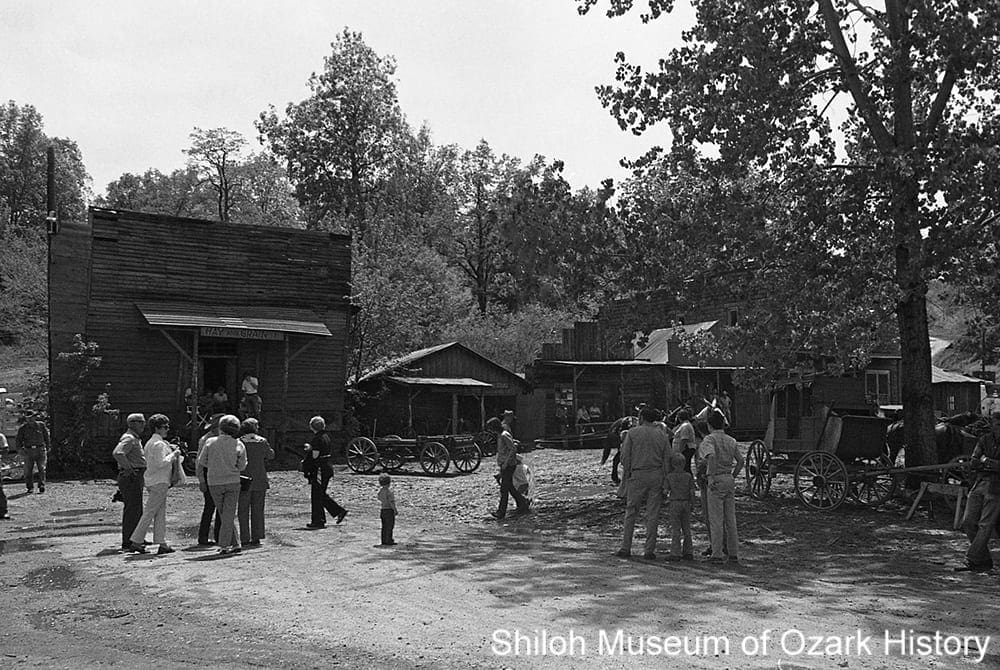
Visitors wander around the movie set of Smoke in the Wind, Winslow, May 6, 1971. Ken Good, photographer. Northwest Arkansas Times Collection (NWAT Box 24 71.1)
After co-producer Robert Hughes paid a visit to his brother in Fort Smith, he was so taken “with the beauty of Arkansas with fall colors” that he decided to make a movie in the area. Script problems for Smoke in the Wind led to the film being made in the spring, rather than the fall.
Several weeks were spent “face lifting” downtown Winslow, including Hugh Smith’s General Store, which was transformed into multiple storefronts such as a boot and saddle shop, livery (horse stable), saloon, feed-and-grain store, and blacksmith shop. The sets were built by the G. H. Construction Company of Fort Smith. Seen in the film is the old Jones homestead, described as a “turkey-trot type home with a full-length front port and central hallway.” It was located on Lee Creek about halfway between Lincoln and Van Buren.
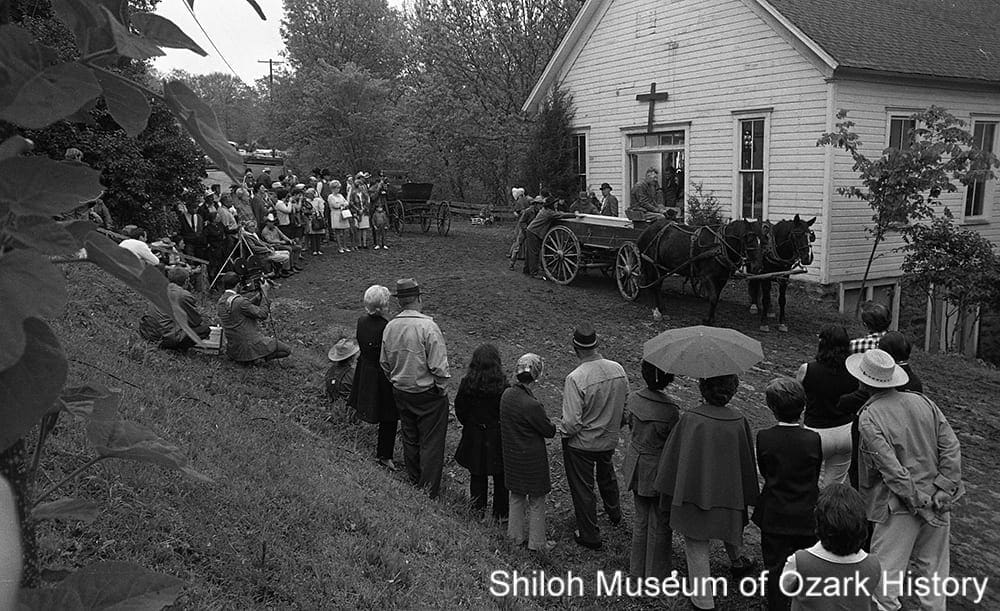
Visitors watch a funeral scene being filmed for Smoke in the Wind, Winslow, May 5, 1971. Charles Bickford, photographer. Springdale News Collection (SN 5-5-1971)
Hundreds of tourists came to watch the moviemaking and visit the set. The first scene filmed, that of a funeral at a country church, was made difficult by moving clouds which continually altered the brightness of the scene. Onlookers stood nearby, cameras in hand. Some of the actors stayed in Fort Smith while others were housed at Mt. Gaylor. Lunch was served in the cafeteria of the Winslow School where, on the first day of filming, the lunchroom workers were busy taking souvenir photos of actors and crew.
Fighting Mad (1975)
The thrilling tale of an Arkansas horse farmer who tries to fight off strip-mining interests, only to seek revenge once family members are killed.
Starring Peter Fonda, Gene Allen Franco, Harry Northup
Filmed October–November 1975 in Springdale (airport, Landmark Mobile Home Park), Fayetteville (Washington County Jail, Brenda’s Bigger Burgers, Swingin’ Door), Wyman, Bentonville (Joe Applegate house), Johnson (limestone quarry), and Greenland.
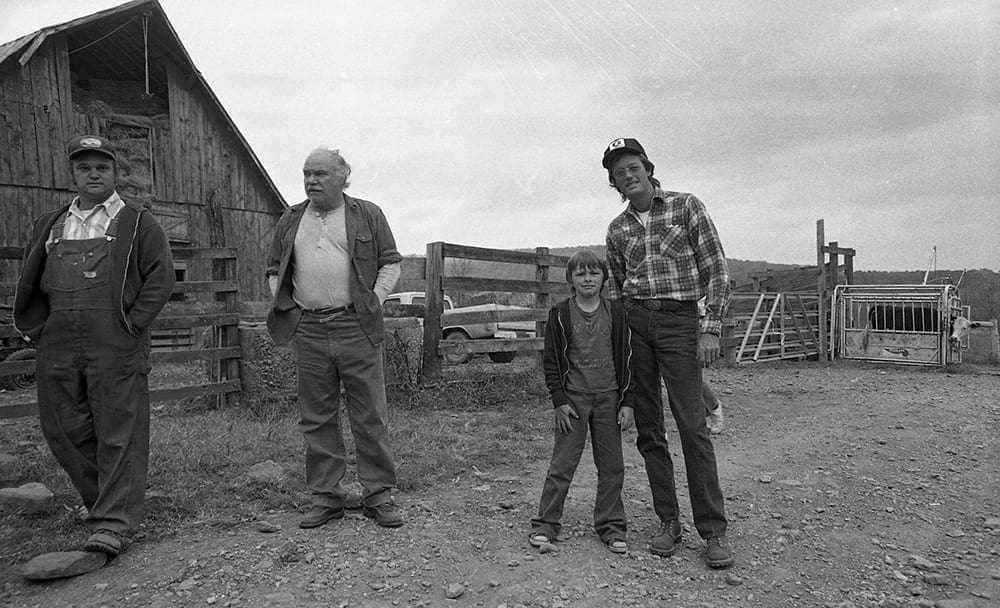
Actors on the set of Fighting Mad, October 23, 1975. With John Doucette (second from left) and Gene Allen Franco and Peter Fonda (on right). Charles Bickford, photographer. Springdale News Collection (SN 10-23-1975)
When news of the movie Fighting Mad was announced, it was expected that 400 extras would be needed for the film, all to be cast locally. Gene Allen Franco of Springdale was cast as star Peter Fonda’s son. The eight-year-old worked on the set from dawn to dark, about four days a week. As a newspaper reporter put it, “Life for [Gino was] a collage of cameras, memorizing lines and hanging around with his friend Pete.”
Seventy-six-year-old Berslie Watson was discovered while having lunch “where the elderly people eat in Springdale.” Director Jonathan Demme “asked if I could ride a bike and run and I said I thought so.” She ran in one scene and was “thrilled to death” that the filmmaker got the take he wanted on her first try.

Preparing to film a chase scene for Fighting Mad at the Springdale airport, with a soundman strapped to the hood of a car, November 2, 1975. Morris White, photographer. Springdale News Collection (SN 11-2-1975)
Third-graders from Washington Elementary School in Fayetteville were used in a scene involving a bus crashing into an autumnal pumpkin display. Jennifer Pinkerton Cook remembers how fun it was that Fonda signed autographs; she still has hers. Local band Zorro and the Blue Footballs played in the background of a scene shot at the Swingin’ Door. Fonda and Demme had seen the band at the saloon and had the group written into the script. They sang “The Bleeding Hearts Inn” and “Cry of the Wild Goose” and were paid $300.
The police are said to have made numerous calls to the cast and crew’s hotels for drunken and disorderly conduct. Rudeness to locals, especially the old Dickson Street crowd, led one person to comment that folks were happy to see them go. When asked about Northwest Arkansas, Fonda said, “We like Fayetteville fine. The people in Arkansas have been very cooperative, from the governor’s office on down. The police and officials here have been very helpful. We would consider coming back.”
The Blue and the Gray (1982)
The epic tale of two sisters and their families who find themselves on opposing sides during the Civil War.
Starring Stacy Keach, Gregory Peck, Lloyd Bridges, Colleen Dewhurst, John Hammond, Diane Baker, Julia Duffy
Filmed August–December 1981 at over 100 locations, including Fayetteville (University of Arkansas), Winslow, Beaver, Eureka Springs, Lake Wedington, Cave Springs, Elkins, Springdale, Wesley, Prairie Grove, Prairie Grove Battlefield State Park, and Eureka Springs & North Arkansas Railway

Actor Gregory Peck arriving on set of The Blue and the Gray for the reading of the Gettysburg Address, Circle H Farms, Fayetteville, September 27, 1981. Charles Bickford, photographer. Springdale News Collection (SN 10-27-1981)
Architecture historian Cyrus Sutherland was enlisted to find appropriate buildings for The Blue and the Gray’s many location shots, including the historic Headquarters House, which was actually under siege during the Battle of Fayetteville in 1863. With the help of Hollywood magic, the modern pavement of Fayetteville’s Washington Street disappeared under a layer of topsoil and Old Main on the University of Arkansas campus was transformed into Ford’s Theater, where President Lincoln was shot. The deathbed scene was filmed in an old shoestring plant in Springdale. Legendary UA athletic director Frank Broyles played one of Lincoln’s doctors. The production’s wardrobe, valued at $16–18 million (nearly equal to the film’s budget) was stored in a Springdale warehouse. It included Scarlett O’Hara’s famous green velvet dress (made from curtains) from Gone with the Wind.
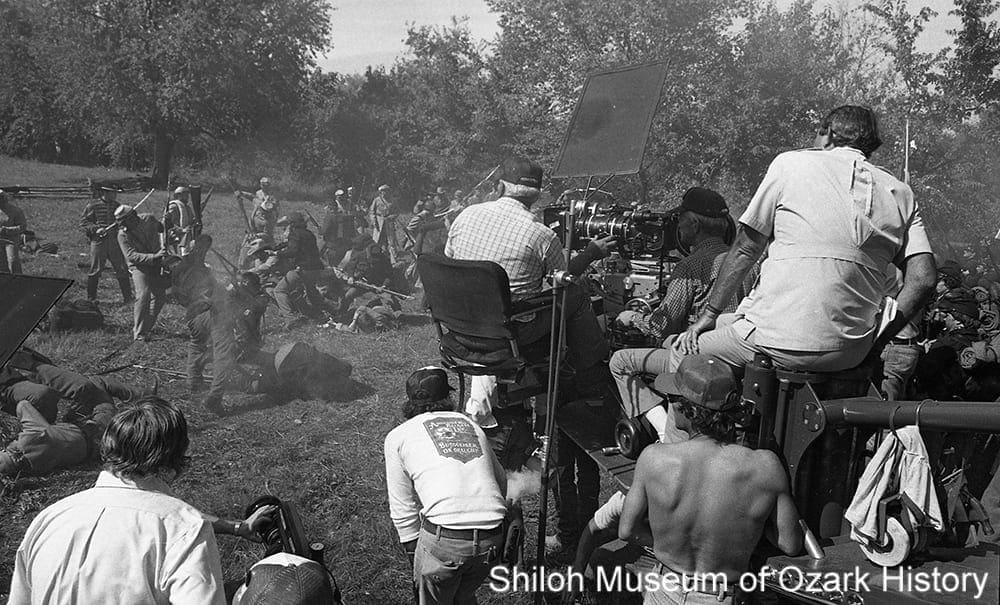
Filming the “Battle of Bull Run” for The Blue and the Gray, Prairie Grove Battlefield State Park, October 2, 1981. Charles Bickford, photographer. Springdale News Collection (SN 10-3-1981)
The production company appreciated the friendliness and enthusiasm of Northwest Arkansas residents, who allowed their homes to be used as sets and sponsored fishing derbies and dinners for the crew. One day the director, actors, and crew stopped filming to watch Prairie Grove’s homecoming parade. An expensive proposition, as the average hourly production cost was $8,000.
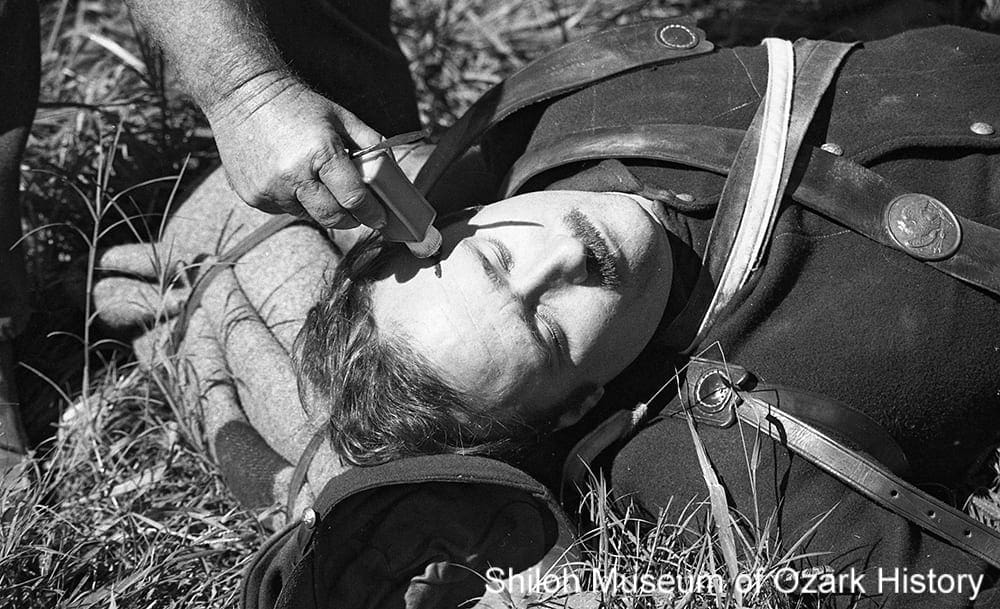
A re-enactor receives a “head wound” from a makeup artist during filming of The Blue and the Gray, Prairie Grove Battlefield State Park, October 2, 1981. Charles Bickford, photographer. Springdale News Collection (SN 10-3-1981)
An estimated $11–17 million was spent in Northwest Arkansas. Thousands of folks were employed as actors and extras (the latter sometimes called “atmospheres” by the crew). Cal Kinzer, park historian at Prairie Grove Battlefield State Park, served as the film’s military coordinator and technical advisor, arranging for about 350 Civil War re-enactors, including the Union Rifles, a local unit.
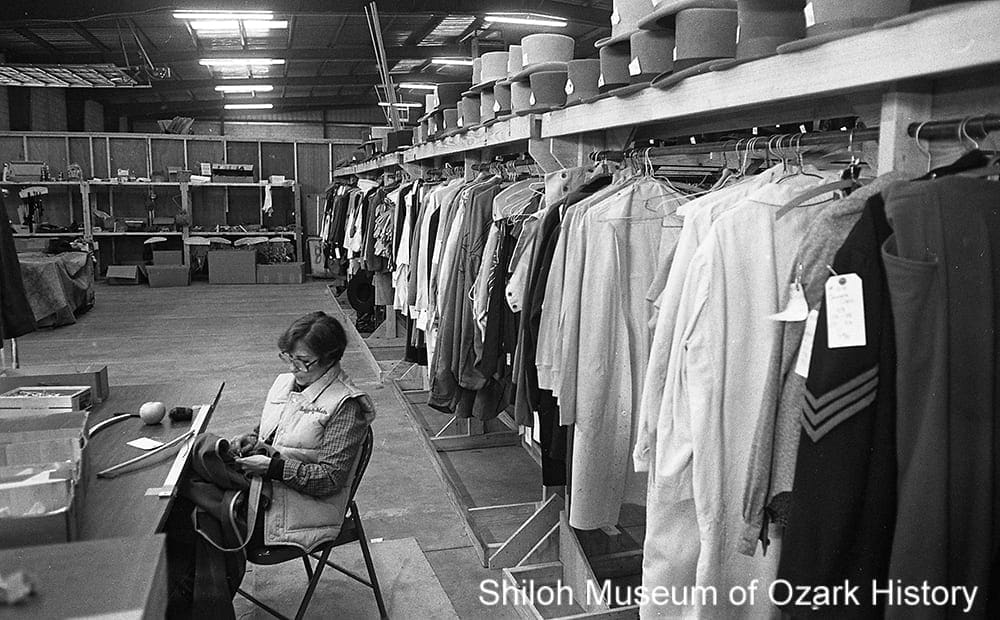
Seamstress at Columbia Pictures’ warehouse for The Blue and the Gra, Springdale, October 9, 1981. Guy Barnes, photographer. Springdale News Collection (SN 10-9-1981)
The miniseries’ premiere was held at the Malco Twin Cinema in Springdale. Several actors attended, including Stacy Keach. A reception was held at the Rodeo of the Ozarks community center. At the theater, Civil War re-enactors fired a gun salute as folks entered.
Man Outside (1987)
The suspenseful tale of a lawyer who’s been living in the woods as a hermit and the anthropologist who tries to figure out why, when he becomes the suspect in a missing-child case.
Starring Robert Logan, Kathleen Quinlan, Bradford Dillman, Levon Helm, Rick Danko, Patricia Relph
Filmed October–November 1985 in Fayetteville (Markham Hill, University of Arkansas campus), Johnson (post office), and Springdale (jail, municipal law library)
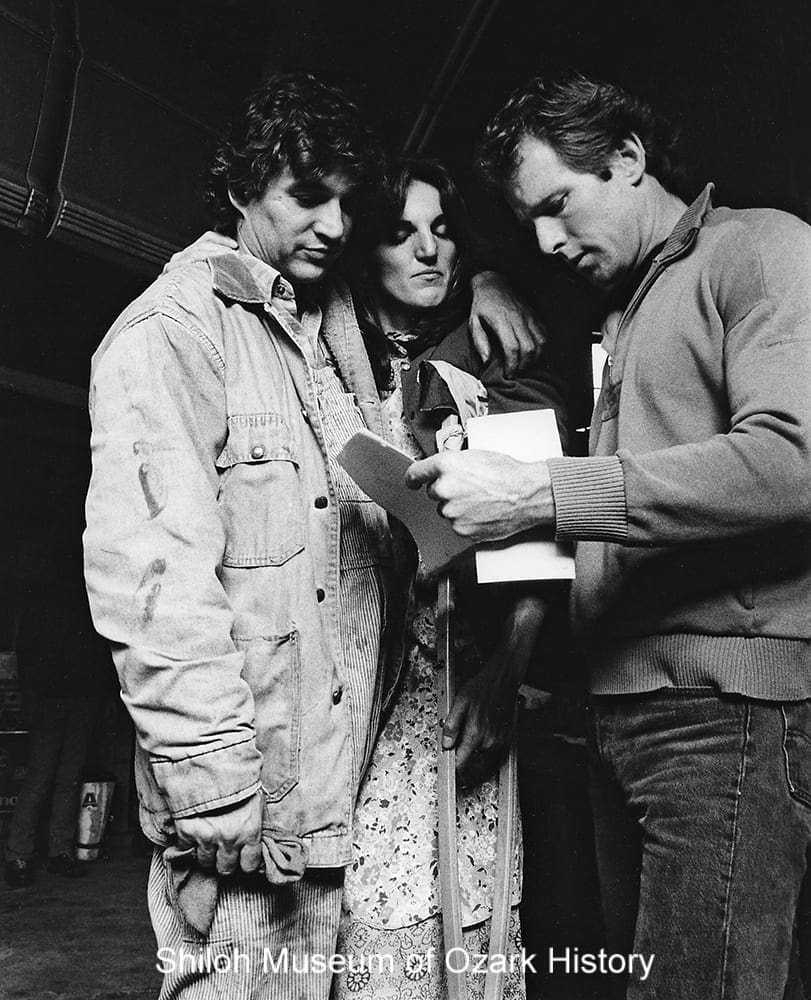
Actors Rick Danko and Patricia Relph (left) discuss a scene with Man Outside director Mark Stouffer, Fayetteville, November 1985. Northwest Arkansas Times Collection (NWAT Box 44 84-5-20 Nov)
Fort Smith native Mark Stouffer, director, co-writer, and co-producer, wrote Man Outside (originally titled The Tuscaloosan: A Solitary Man) “explicitly for Fayetteville,” calling it “a wonderful place to structure a story.” Members of the legendary country rock group, The Band, had roles in the film, including Rick Danko and Levon Helm.
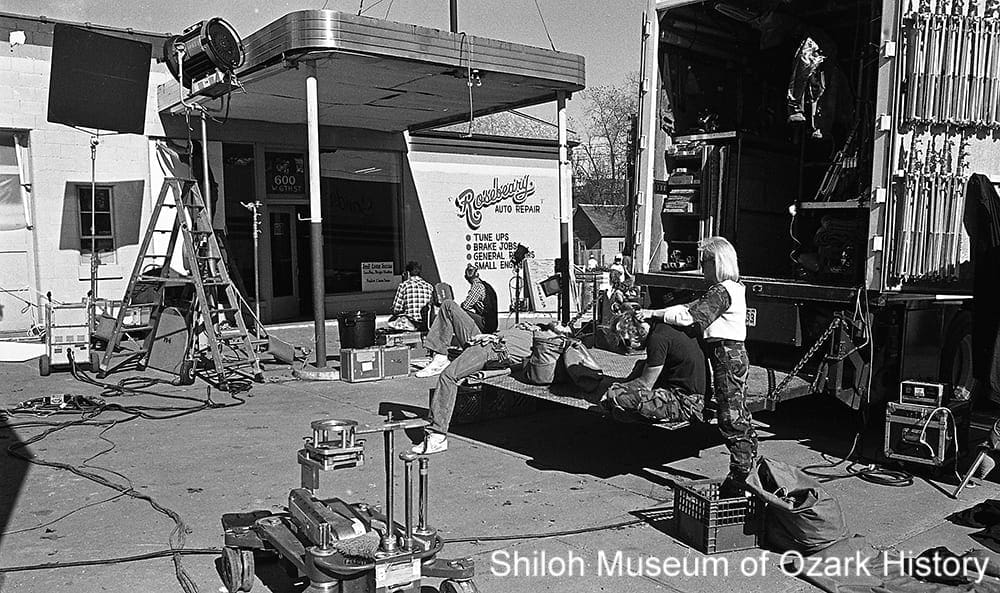
Crew and gear in-between scenes of Man Outside, Fayetteville, November 1985. Northwest Arkansas Times Collection (NWAT Box 44 84-5-20 Nov)
Many Northwest Arkansas residents were cast, including Springdale businessman Philip Steele, Patricia Relph of the University of Arkansas drama department (she also worked as a wardrobe assistant), law enforcement professionals Larry Fletcher, Bill Wolber, Kaine Garrett, and John Harris, and newsmen Guy Barnes and Mark Remes. During the filming of the courthouse scene, Barnes remembers taking up position “standing close to [the film] producer’s daddy,” thus ensuring that he would be seen on screen.
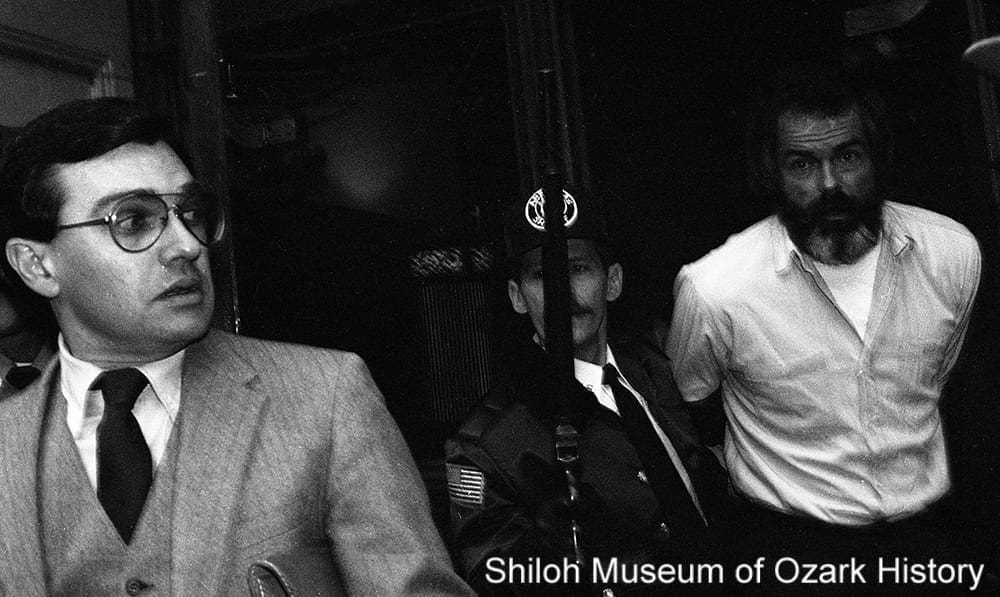
Actors filming the courthouse scene for Man Outside, with Levon Helm (middle), and the movie’s star, Robert Logan (right), Fayetteville, November 21, 1985. Guy Barnes, photographer. Springdale News Collection (SN 11-21-1985)
When lead actress Kathleen Quinlan was told that in one scene she would be running from a wild boar, she said “I will jump from high places, even dive into cold water, but I will not be chased by a wild boar.” Fortunately for her, the boar was played by a 400-pound pet pig. Also in the movie was “Chessie,” a dog who shared a room at the Fayetteville Hilton with her handler and attended a reception for cast and crew put on by the Northwest Arkansas Motion Picture Commission.
Pass the Ammo (1988)
The comedic tale of a televangelist whose weekly broadcast is interrupted by rednecks, robbers-turned-hostage-takers, and the various entities struggling to end the crisis.
Starring Bill Paxton, Tim Curry, Annie Potts
Filmed February–April 1987 in Eureka Springs (city auditorium), Green Forest (Billie’s Bar), and Clifty (Clifty Store)
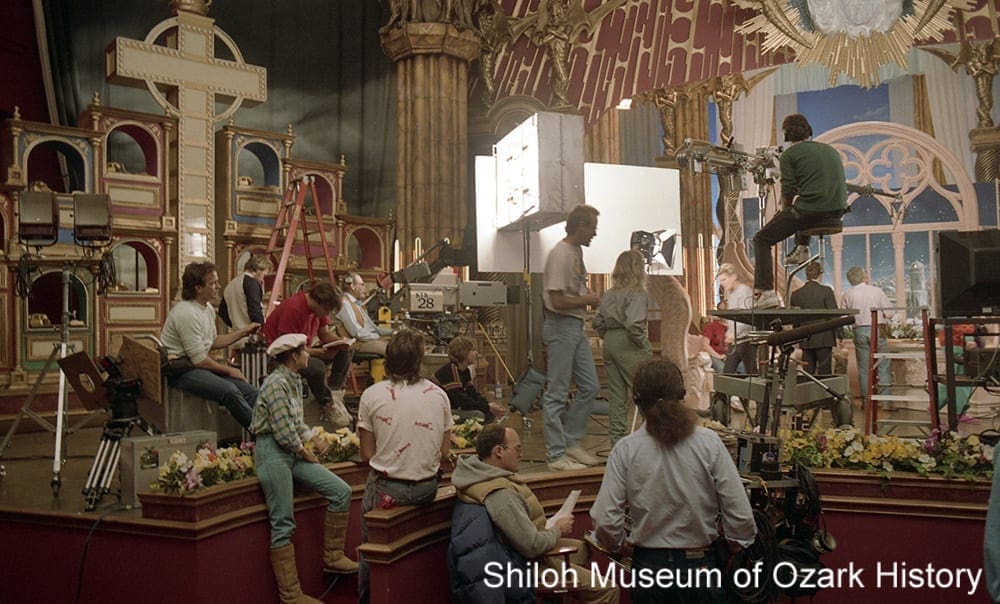
Crew preparing to film a scene for Pass the Ammo at the city auditorium, Eureka Springs, February 26, 1987. Springdale News Collection (SN 2-26-1987)
When word went out about needing extras for Pass the Ammo (originally titled Pass the Ammunition), the casting director advertised for singers and dancers as well as folks who were “structurally unique” with “large noses and large bottoms and such.” The filmmakers employed locals as extras and crew and patronized area businesses, hotels, and restaurants, pumping an estimated $2 million into the area economy. The historic city auditorium became the fictional “Tower of Bethlehem” church. Statues and a false stone front were added to the building’s exterior, which was demolished by a tank in the final scenes of the movie.
But not everyone was happy with the movie, a spoof about crooked televangelists. After several local pastors read the script, they denounced it as being full of “nudity, sex, obscenity, perversity, drugs, vulgarity, racism, and violence.” Mayor Richard Schoeninger replied, “If it were pornographic, I would be forced to stop it.” Some criticized that the movie would make “Arkansans and Eureka Springs look backwards and hillbilly.” The Elna M. Smith Foundation, owners of the “Christ of the Ozarks” statue, deplored the movie. Protesters (led by a Foundation employee) picketed cast and crew. To keep it from being filmed, the statue was draped in black plastic “for restoration work.” But early shots taken of the undraped statue made it to the final cut.
Pass the Ammo was never shown in Arkansas due to financial problems which forced the production company to sell the film rights for video release. But local folks worked hard to hold a premiere in Fayetteville, sponsored by the Northwest Arkansas Motion Picture Commission. As chairman Philip Steele of Springdale noted, “This movie was shot in Arkansas, using a lot of Arkansas people and we are tickled that it will be shown here. We want our membership to see how exciting the film industry can be.”
Frank and Jesse (1994)
An action-packed tale of how the James and Younger brothers and their co-horts turn to a life of crime after being oppressed by Chicago railroad investors and Union soldiers.
Starring Rob Lowe, Bill Paxton, Randy Travis
Filmed December 1993–January 1994 in Fayetteville, Pea Ridge, Winslow, Eureka Springs, Prairie Grove, Chester, and War Eagle Cavern. Railroad scenes featured the Winslow Tunnel, the railcar on Dickson Street used as a branch location of the Bank of Fayetteville, and historic trains operated by the Eureka Springs & North Arkansas Railway and the Arkansas & Missouri Railroad.

Surrounded by crew members, star Rob Lowe (center, with beard) prepares to shoot a stump-pulling scene for Frank and Jesse, December 11, 1993. William Cooksey, photographer. Northwest Arkansas Times Collection (NWAT 12-11-1993)
About 1,500 folks applied to be extras in Frank and Jesse (originally titled Lone Rider). Some folks were cast because of their beards while others had “matronly appeal, a waspish waist, or long hair that could easily be twisted into a period style.” Mike Whitehead and his family were cast as mourners in one scene. He said, “It was great. It was fun to watch the actors and be part of the action.” Shane McNair of Gentry was part of the sound crew, working twelve-hour days, six days a week, for $300 a week. “The money wasn’t that good, but it was fun.” He enjoyed working with the actors but they were “just . . . co-workers. It was boring after a while.” McNair noted that country musician and actor Randy Travis, who played Cole Younger, often visited with fans and signed autographs.
Catherine Bruce of Fayetteville helped with wardrobe. She said, “In the art of movie making, what you see on the silver screen many times is the result of special effects, hard work, and a bit of magic.” For instance, a vest worn by star Rob Lowe had a red-stained “vest double,” worn after the actor was “shot.” Many props were brought from California, but some were rented or purchased locally. One scene required a kerosene bomb, fabricated in part from dowel rods and a can of beans bought at Walmart. A gallows was built near Goshen at the weekend retreat of Dr. Harvey and Amy Smith. Their log cabin was transformed into Jesse James’ home, complete with period furnishings and a reproduction wood stove from Rogers’ House of Webster.
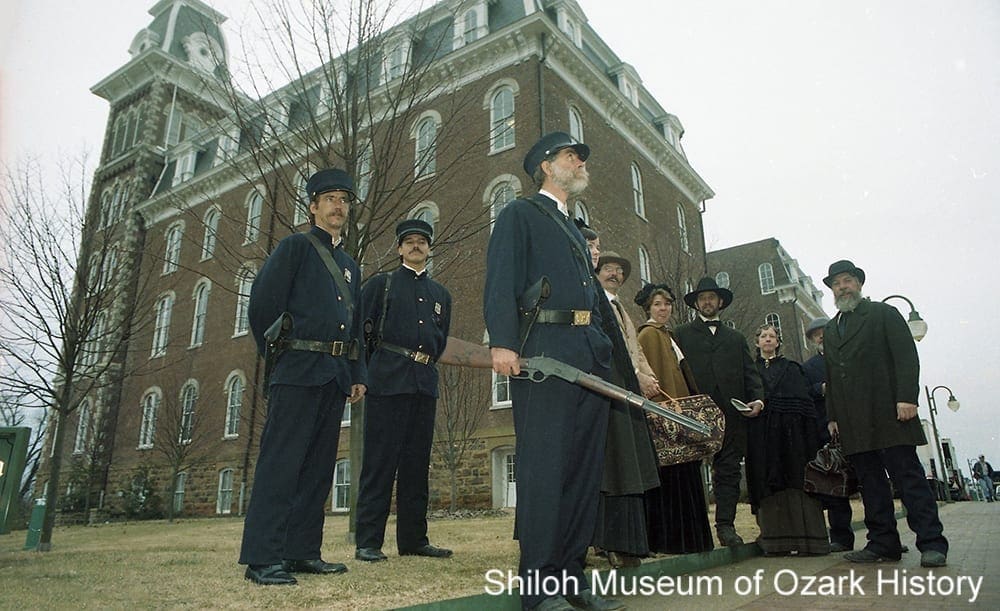
Extras waiting for their scene for Frank and Jesse in front of Old Main, University of Arkansas, Fayetteville, January 11, 1994. William Cooksey, photographer. Northwest Arkansas Times Collection (NWAT 1-11-1994)
Fayetteville residents Kenneth Williams and Eric Gordon served as location managers, securing contracts with property owners. “When a film company comes in, fences are removed and buildings altered. We come along behind and make sure everything goes back the way it was before.” Of the company’s time in the area, producer Cassian Elwes said, “It’s been a lot of fun. The people of Arkansas are so warm and gracious. We’ll take home a lot of nice memories.”
Recent Movies
Chrystal (1994)
The dramatic tale of a convict returning home after causing a car crash that killed his son and injured his wife, and how he has to face the challenges of reuniting with her while leaving his old drug-dealing ways.
Starring Billy Bob Thornton, Lisa Blount
Filmed in Eureka Springs
Mr. Christmas (2005)
A heartwarming Depression-era tale of a young girl who asks for the perfect gift from Santa, which her father can’t afford.
Starring Jace McLean, Jen Celene Little, Ireland Rose Maddox
Filmed in Eureka Springs
Elizabethtown (2005)
A romantic tale of a failed shoe designer who is contemplating suicide but is halted by the death of his father, only to meet a friendly flight attendant who helps him come to terms with his life and find love.
Starring Orlando Bloom, Kirstin Dunst, Susan Sarandon, Alec Baldwin
One scene filmed in Beaver (Little Golden Gate Bridge)
War Eagle, Arkansas (2007)
A compelling tale of a high school student with a stutter who relies on his friend (who uses a wheelchair) to help him speak to people, but the two don’t see eye-to-eye about the girl one of them is sweet on.
Starring Brian Dennehy, Mary Kay Place, Luke Grimes, Dan McCabe
Filmed in Eureka Springs, Huntsville, Fayetteville, War Eagle, Berryville, Buffalo National River
Gordon Family Tree (2012)
The coming-of-age tale about an unfulfilled architect who takes a road trip and builds secret tree houses for the children of the generous folks he meets along the way, and who comes to understand the virtue in doing what he loves.
Starring Corbin Bernsen, Richard Karn, Jennica Schwartsman
Filmed in Fayetteville
Valley Inn (2014)
A comedic tale of an East Coast college student who finds herself selling Christian books door-to-door in a small town, only to have the quirky but endearing locals show her what’s most valuable in life.
Starring Joey Lauren Adams, Natalie Canerday
Filmed in Hindsville (Valley Inn Café), Springdale (Rodeo of the Ozarks)
Greater (2016)
The true story of Brandon Burlsworth and his struggle to become a Razorback football player at the University of Arkansas, before his tragic death at age twenty-two.
Starring Christopher Severio, Neal McDonough, Quinton Aaron, Nick Searcy
Filmed in Springdale, Farmington, Gravette, Lincoln, Fayetteville (Razorback Stadium, Broyles Athletic Center, Old Main), Harrison
True Detective [Season Three] (2019)
Spanning several decades, a detective investigates a terrible crime committed in the Ozarks involving two children.
Starring Mahershala Ali, Carmen Ejogo, Stephen Dorff, Scoot McNairy, Ray Fisher
Filmed in Fayetteville, Bentonville, Lincoln, Rogers, Springdale, Huntsville (Tugboat’s Place)
Local Movie Theaters
P-4129
Lyric Theatre, Fayetteville, about 1915. Washington County Historical Society Collection (P-4129). Originally opened as an airdome (an open-air theater) in 1908, the Lyric moved into an enclosed building in 1913 so it could show movies during the winter. The building was torn down in 1945.
P-43
Ozark Theatre, Fayetteville, 1940. Washington County Historical Society Collection (P-43). The Ozark opened in 1907 in the Knights of Pythias Hall. The building was slated for destruction in the mid 1990s, but preservation-minded individuals helped save it. Today it houses office space.
90-196-32
Victory Theatre, Rogers, December 1927. Herbert Locke Collection (S-90-196-32). Prominent Rogers architect A. O. Clarke designed the building in 1927. It became the Cine Theatre until 1976. For a while the building housed a flea market. Today it is home to the Arkansas Public Theatre, an acting company.
90-196-31
Victory Theatre, Rogers, December 1927. Herbert Locke Collection (S-90-196-31). The Victory Theatre was state-of-the-art for its day. The first building in Rogers to be air-conditioned, it had a twelve-foot stage, outstanding lighting and acoustics, comfortable upholstered chairs, a chandelier in the lobby, and a pipe organ to accompany silent movies.
85-322-18
Barker theater, Pettigrew (Madison County), 1930s. Wayne Martin Collection (S-85-322-18). The theater was owned by Arthur Barker, who also ran a drugstore in town. During the 1930s Baker’s daughter and granddaughters operated the player piano that was used to accompany silent movies. The building still stands today, but is in poor shape.
P-2470
UArk Theatre, Fayetteville, January 1941. Washington County Historical Society Collection (P-2470). William F. Sonneman built the single-screen UArk in 1940 to attract the University of Arkansas crowd. The theater operated on and off throughout the 1970s, changing its name a few times, before closing its doors in 1980. For a time the building housed retail shops but is now empty.
96-48-7
Apollo Theatre, Springdale, July 1950. Maudine Sanders Collection (S-96-48-7). William F. Sonneman built the Apollo in 1949. A change in ownership led to the showing of X-rated movies in the early 1970s; it was forced to close in 1975. Today’s ownershave turned it into an events venue.
NWAT-5-56-8-55
71 Drive-In Theater, Fayetteville, about 1957. Northwest Arkansas Times Collection (NWAT Box 5 56-8.55). Opened in 1949, the 71 had a large snack bar, children’s playground, and rows for high school and college students. While other drive-ins offered adult movies in the 1970s, the 71 kept to family films. The 71 was torn down in 1980 to make way for Walmart.
NWAT-20-69-19A
62 Drive-In Theatre, Fayetteville, 1969. Northwest Arkansas Times Collection (NWAT Box 20 69.19A). The 62 opened in 1969. In 1973 a “stunned” Fayetteville City Council was shown explicit photos taken of the 62’s screen, leading to a “nudie” film ordinance which banned certain movies “being visible from public streets.” The 62 was torn down and replaced with a Walmart.
SN-7-1976-10
Malco Twin Cinema, Fayetteville, August 1970. Morris White, photographer. Springdale News Collection (SN 7/1976 #10). The Twin opened in 1970 and was the first two-screen theater in Fayetteville. It had wood-paneled walls, turquoise drapes, red seats and carpeting, a covered entrance, and a concession stand. The theater may have closed in the late 1980s. The building now houses office space.
Credits
Barnes, Guy. “‘Hodge-Podge’ Uniforms Get Careful Research.” Springdale News, 10-18-1981.
———. “Man Outside Story Triumphs.” Springdale News, 10-29-1986.
———. “Motion Picture Wizards Weave Webs of Illusion.” Springdale News, 12-14-1981.
———. “Scenes for Solitary Man Unfold Atop Wooded Hill.” Springdale News, 11-17-1985.
Barr, Michael. “Extra! Extra! An ‘Atmosphere’ Speaks.” [Fayetteville] Grapevine, 11-10-1982.
Bowden, Bill. “Eureka Springs studying moviemaker tax rebate.” Arkansas Democrat-Gazette, 1-13-2014.
———. “Hindsville café stars in Arkansans’ movie.” Arkansas Democrat-Gazette, 7-14-2013.
Bradley, Larry. 20th Century-Fox Production of Jesse James. McDonald County Press: Noel, Missouri, 1970.
Brooks, Kristen. “Northwest Arkansas Motion Picture Commission Hard at Work.” Springdale News, 8-2-1987.
Busby, Jonathan. “Oscar-Winner Brennan Stars in Movie at Winslow.” Arkansas Gazette, 5-9-1971.
Button, Patrick. Can Motion Picture Incentives Create a Local Film Company?, academia.edu, 7-17-2014. (accessed 2015; no longer available 6/2020)
Carl, Floyd Jr. “Mostly the truth.” Washington County Observer, 9-11-1986.
Davies, David. “Stories Behind the Scenes Make Memorable Film.” Northwest Arkansas Times, 12-20-1981.
Eureka Springs Times-Echo. “Free Blue and Gray premiere will help promote new regional film commission.” 8-19-1982.
Fayetteville History Facebook page. Fighting Mad memories. (accessed 4/2015)
Franco, Cheree. “The price of “made in Arkansas.” Arkansas Times, 6-20-2012.
Fry, Ben. “Movies.” CALS Encyclopedia of Arkansas (accessed 4/2015)
Greer, Edna L. “Filming of Jesse James.” Ozarks Mountaineer, July 1970.
Gute, Melissa. “Studio looks to boost film industry in region.” Northwest Arkansas Democrat-Gazette, 2-10-2019.
Hall, Grant. “Film Makers Draw Crowd.” Northwest Arkansas Times, 11-4-1975.
Harrison Daily Times. “Changes in Eureka Script Announced.” 1-23-1987.
———. “Concerns Continue About Eureka Film.” 1-22-1987.
———. “Filming of Movie at Eureka Announced,” Harrison Daily Times, undated news clipping in Shiloh Museum research files. (probably January/February 1987).
Hogan, J. B. “From the Lyric to the UArk: Fayetteville’s Old Movie Houses.” Flashback (Washington County Historical Society), Vol. 58, No. 4.
James, Dena. “Clifty Store ‘Robbed’ for Upcoming Movie.” Madison County Record, 4-9-1987.
Jones, Glenn. Email to Shiloh Museum regarding Wonder Valley, 8-28-2007.
Jones, Matt. “Takeaways from Brandon Burlsworth movie, Greater.” WholeHogSports.com, 8-24-2016. (accessed 6/2020)
Kelley, Ashley S. “Warm Reception: Victory’s First Grand Opening Was to a Packed House.” Rogers Morning News, 9-23-2000.
Kinder, Kevin. “Lights! camera! action!: Valley Inn crew collects, breeds Arkansas movie talent.” Arkansas Democrat-Gazette, 7-14-2013.
Kinzer, Cal. “The Blue and the Gray in Northwest Arkansas.” Flashback (Washington County Historical Society), Vol. 32, No. 4.
Klossner, Michael. “Fighting Mad.” CALS Encyclopedia of Arkansas. (accessed 4/2015)
Madison County Record. “Pass the Ammo to be Shown in Fayetteville.” 5-25-1988.
Martin, Wayne. Pettigrew Arkansas: Hardwood Capital of the World. Shiloh Museum of Ozark History: Springdale, 2010.
Marts, Kent. “‘Speed, sound; action!'” Benton County Democrat, 3-8-1987.
McNeil, Betsy. “A look behind the scenes of a movie filmed in northwest Arkansas.” Gentry Courier-Journal, 1-26-1994.
———. “Movie Production Involves Numerous Area Workers.” Springdale Morning News, 1-22-1994.
Milton, Mathew. “Lights. Camera. Fayetteville.” AY Magazine, January 2020.
Northwest Arkansas Times. “Filming of Fonda Movie Set for Area.” 10-14-1975.
———. “New Drive-In Theater Opens Thursday Night.” 8-17-1949.
———. “Opening scenes for Ozark movie completed by production crew.” 10-16-1985.
———. “State Hopes Film’s Success Will Attract Movie-Makers.” 1-31-1982.
———. “Winslow to be Movie Setting.” 4-26-1971.
Palmer, Dorothy. “State’s Film Future Bright.” Arkansas Gazette, 9-21-1981.
Ryburn, Stacy. “Rockhill Studios opens doors.” Northwest Arkansas Democrat-Gazette, 4-26-2018.
Saunders, Bev. “Frank and Jesse comes to northwest Arkansas.” Gentry Courier-Journal, 1-26-1994.
Sell, Mary Jean. “Making a movie challenges patience.” Eureka Springs Times Echo, 3-5-1987.
———. “‘Our movie’ finally on screen.” Eureka Springs Times-Echo, 6-2-1988.
Shiras, Ginger. “Applause Welcomes Eureka Movie Debut.” Harrison Daily Times, 5-27-1988.
———. “Arkansas Showing of Pass the Ammo Scheduled.” Harrison Daily Times, 5-20-1988.
Smith, Jamie. “Film industry taking notice of Arkansas (updated).” The City Wire, 4-8-2013. (accessed 4/2015)
Springdale News. “Bigger than ‘Masasa:” McLaglen Recaps Filming of The Blue and the Gray.” 11-17-1982.
———. “Playing with Peter Fonda . . . Is Great Pretending.” 10-26-1975.
Sutherland, Cyrus A. “The Blue and the Gray in Northwest Arkansas: Cyrus A. Sutherland’s Story.” Flashback (Washington County Historical Society), Vol. 32, No. 3 (August 1982).
Tributes.com. Viva Ruth Liles obituary. (accessed 4/2015)
Wakefield, Jim. “The Jesse James Movie Train.” Unpublished manuscript, late 1900s.
“We ought to be in pictures . . . motion pictures in Arkansas.” Uncredited and undated news clipping (possibly Northwest Arkansas Times, 1985). Shiloh Museum research files.
Weddington, Randy. “The Blue and the Gray: An Electrifying Experience.” [Fayetteville] Grapevine, 11-10-1982.

